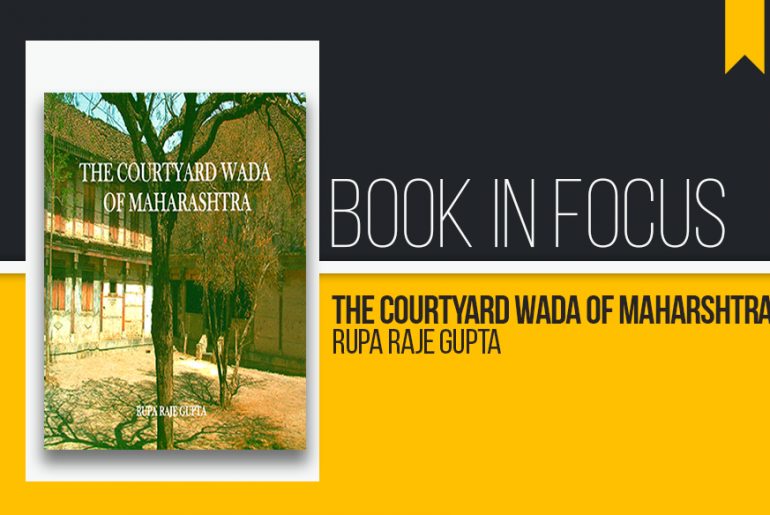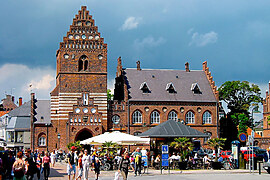If you are looking for an encyclopedia on Wadas of Maharashtra, The Courtyard Wada of Maharashtra by Rupa Raje Gupta is something you would want to have on your bookshelf. The author has delved deep into the traditional dwellings of Maharashtra and covered various aspects of the history of wadas to the social and cultural significance of the variations in the five different regions of Maharashtra. Along with studying the architectural aspects of a wada, the author has also covered the regional and social variations discovered while documenting the 75 wadas across 30 towns in the five different regions of Maharashtra.

The book starts with a background on the geographical location and context of the present state of Maharashtra, which is important to understand the subsequent evolution of the Maharashtrian towns and settlements. The author provides a historical and social background for a better understanding of the evolution of traditional dwellings like the wada. The objective, to provide a framework for the study of traditional Indian architecture across all parts of the country has been firmly established throughout the book. A socio-cultural context with changing timelines and scenarios revolving around the wadas has brought about changes in the functioning of these traditional dwellings. The author has also established a pattern of similar developments all across the country.
Evolution of towns
The book gives insights into the principles of town planning which are deeply associated with ancient texts and scriptures of Vastushastra. A deep relationship between town planning and social structures has been an integral part of every Indian settlement. This pattern is still visible in several cities, especially in the old parts of cities and towns. The planning strategies used for town planning and the development of settlements have been meticulously observed by the author, explaining the stratification of towns during that time. The book has explored various cities and towns, carefully putting together the types of settlements across Maharashtra from political, practical, and agricultural standpoints. Moving from the context to the town planning, the author further delves into observing the hierarchy and habitation patterns of each town or settlement.
Defining a Wada
As we zoom further into the form and function of the wada, certain characteristic principles have been laid, which are common in most wadas. An introvert house form with a definite spatial hierarchy based on social and geographical aspects has been observed, studied, and compiled with an objective. Every aspect and space of a wada has been written in the native language, which becomes crucial when thought about, as the intangible aspects of architecture are rarely documented and eventually lost. Every space and function of a wada is compiled in textual and pictorial form and put forth for readers to understand the function of each space.
When the basic form and function of a wada are understood, the author puts forth the variations found across five different regions of Maharashtra, highlighting the similarities and variables across every region. It also becomes important to understand the reason for these similarities and variables, mostly resting on the geographical and social aspects of the region. Classification in the form of a table and pictorial representation of wadas is helpful for readers and people who want to know more and study the different wadas of different regions (Konkan, Desh, Khandesh, Marathwada, and Vidarbha). With 75 wadas documented across multiple towns and cities spreading across the five regions, the author has compiled the thorough research with a microscopic lens, assessing and observing various aspects of wadas like the form, elevation, design elements, and construction materials along with intangible aspects like rituals and symbolism.
Construction and Materials
The author has documented the construction methodology used in the different regions, along with design elements traversing from regions of India like Rajasthan or North India. Evolution in the construction methodology through the times of Shivaji, Mughals, and Peshwa rule can intrigue the readers’ minds, especially architects and historians. The author discusses the variations in arches visible in different regions of Maharashtra.
The Courtyard Wada of Maharashtra is a book that has researched almost every aspect of a traditional wada along with looking at the intangible aspects of heritage and giving a general overview of the present condition of wadas across Maharashtra. It is hard to find a book that has delved so deep into the architecture, planning, and regional variations of different wadas across Maharashtra. It requires years and years of travel, documentation, research, compilation, and editing to pull off such an incredible feat. The dedication of the author Rupa Raje Gupta is visible through the pages of the book. It remains a book that any architect, conservationist, or historian can study and learn. It is a book that should most certainly, be on your bookshelf!
References:
- Gupta, Rupa Raje. (2007). The Courtyard Wada of Maharashtra. Michigan. ProQuest LLC


















